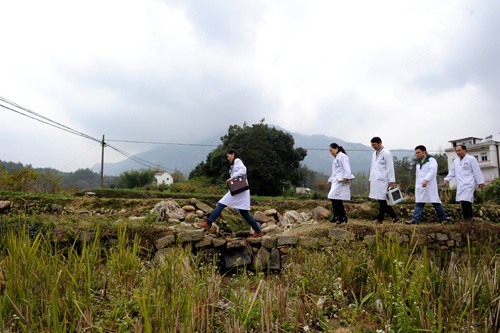|
 |
|
MEDICAL VOLUNTEERS: A medical team from a hospital of Hefei, capital of east China's Anhui Province, offers service to residents in mountains in Yuexi County of the province on November 11, 2014 (XINHUA) |
"Although the rich in China are reaping more benefits, the country's economic success still has great potential to further reduce poverty in most areas in China's relatively poor central and western regions," Li said.
Along with overall GDP growth targets, the government is now focusing on raising the income of the country's population with a current goal to double per-capita income from those recorded in 2010 by 2020.
In an effort to expand the safety net for those in poverty, the Chinese Government raised the poverty threshold to 2,300-yuan ($374) annual net income of farmers in 2011, a 92-percent increase from the standard set in 2009 at 1,196 yuan ($194).
As per the new standard, an estimated 128 million rural residents were living in poverty at the end of 2011, accounting for 13.4 percent of the total rural population.
"The previous poverty line underestimated the number of poor people in rural China," said Wang Sangui, a professor at the School of Agricultural Economics and Rural Development of the Beijing-based Renmin University of China. "Only 2.8 percent of the rural population was officially considered poor, which was lower than many developed countries such as the United States, which has a poverty rate of about 15 percent."
Wang believes the new poverty standard better reflects the situation in China and will bring more resources to poverty-stricken regions.
In the following two years, China further lowered its population living under the state poverty line of 2,300 yuan per capita a year to 82.49 million by the end of 2013, according to LGOPAD figures.
A lasting battle
In a teleconference on October 17 last year, the country's first Poverty Relief Day, Chinese President Xi Jinping pledged to make continued efforts to fight poverty. He asked authorities to mobilize all social forces to join the war against poverty, as the most arduous task in building a well-off society is raising the poor out of poverty.
China should continue innovating and take differentiated and targeted steps to deliver more people from hunger, Xi said.
Although some 660 million people were lifted out of poverty between 1978 and 2010, some 82.49 million people remain in poverty in rural areas as of the end of 2013, according to official data.
Zheng Wenkai, Deputy Director of the LGOPAD, said at a press conference in Beijing that poverty is still a salient problem in China.
"As of the end of 2013, demographically, 82.49 million people are still trapped in poverty according to China's poverty line, and 200 million according to the international one," he said.
Data from the office also show that 128,000 villages in 832 key counties including those located in extremely poor contiguous regions remain poverty-stricken.
Poor people are not only poorly paid, but also beset by unavailability of water, roads, electricity, schooling, healthcare and lack of access to higher incomes or loans.
Zheng admitted that there are difficulties in solving these problems as poor populations are concentrated in extremely poor contiguous regions with substandard living conditions and inadequate infrastructure in addition to vulnerability to natural disasters.
Li Shi, a professor of economics at Beijing Normal University, said that he is not surprised by the number of those classified as impoverished as China has a huge population compared to other countries, so it is understandable that it has a relatively high population living below the poverty line.
The poverty alleviation authority also vowed in October last year to reform a program assisting counties designated as national-level poverty-stricken counties after widespread public complaints over some of these counties' misuse of poverty alleviation funds and their reluctance to exit the program.
In December 2013, the National Audit Office reported that some funds set aside for underdeveloped regions had been misused based on an audit carried out across 19 targeted counties in six provincial-level regions of Guangxi, Yunnan, Guizhou, Shaanxi, Gansu and Ningxia in April and May of that year. It audited funds appropriated to these counties from 2010 to 2012.
During the three-year period, 3.92 billion yuan ($643 million) was injected into the 19 counties with the audit checking 32 percent of it, or 1.24 billion yuan ($203 million).
The audit found that 326 million yuan ($53 million) had been misused through false declaration, embezzlement and officials' wasting on expensive gifts, banquets and tours. The results led to a total of 137 individuals being investigated.
Meanwhile, many counties took a short-sighted approach, using the fund by simply giving money to the poor instead of taking more diverse and efficient supportive measures, said Liu Zhongcheng, head of the poverty relief office of the Inner Mongolia Autonomous Region.
| 